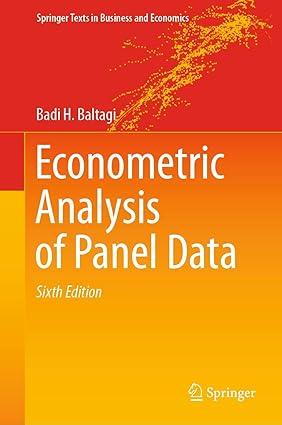Bounds for (s^{2}) in a two-way random effects model. For the random two-way error component model described
Question:
Bounds for \(s^{2}\) in a two-way random effects model. For the random two-way error component model described by (2.1) and (3.1), consider the OLS estimator of \(\operatorname{var}\left(u_{i t}ight)=\sigma^{2}\), which is given by \(s^{2}=\widehat{u}_{O L S}^{\prime} \widehat{u}_{O L S} /\left(n-K^{\prime}ight)\) where \(n=N T\) and \(K^{\prime}=K+1\).
(a) Show that
\[\begin{aligned}E\left(s^{2}ight)= & \sigma^{2}-\sigma_{\mu}^{2}\left[\operatorname{tr}\left(I_{N} \otimes J_{T}ight) P_{x}-K^{\prime}ight] /\left(n-K^{\prime}ight) \\& -\sigma_{\lambda}^{2}\left[\operatorname{tr}\left(J_{N} \otimes I_{T}ight) P_{x}-K^{\prime}ight] /\left(n-K^{\prime}ight)\end{aligned}\]
(b) Consider the inequalities given by Kiviet and Krämer (1992) which are reproduced in problem 2.14
, part (b). Show that for the two-way error component model, these bounds are given by the following two cases:
(1) For \(T \sigma_{\mu}^{2} \[\begin{aligned}0 & \leqslant \sigma_{u}^{2}+\sigma_{\mu}^{2}(n-T) /\left(n-K^{\prime}ight)+\sigma_{\lambda}^{2}\left(n-N K^{\prime}ight) /\left(n-K^{\prime}ight) \leqslant E\left(s^{2}ight) \\& \leqslant \sigma_{u}^{2}+\sigma_{\mu}^{2}\left[n /\left(n-K^{\prime}ight)ight]+\sigma_{\lambda}^{2}\left[n /\left(n-K^{\prime}ight)ight] \leqslant \sigma^{2}\left(n / n-K^{\prime}ight)\end{aligned}\] (2) For \(T \sigma_{\mu}^{2}>N \sigma_{\lambda}^{2}\) : \[\begin{aligned}0 & \leqslant \sigma_{u}^{2}+\sigma_{\mu}^{2}\left(n-T K^{\prime}ight) /\left(n-K^{\prime}ight)+\sigma_{\lambda}^{2}(n-N) /\left(n-K^{\prime}ight) \leqslant E\left(s^{2}ight) \\& \leqslant \sigma_{u}^{2}+\sigma_{\mu}^{2}\left[n /\left(n-K^{\prime}ight)ight]+\sigma_{\lambda}^{2}\left[n /\left(n-K^{\prime}ight)ight] \leqslant \sigma^{2}\left(n / n-K^{\prime}ight)\end{aligned}\] In either case, as \(n ightarrow \infty\), both bounds tend to \(\sigma^{2}\) and \(s^{2}\) is asymptotically unbiased, irrespective of the particular evolution of \(X\). See Baltagi and Krämer (1994) for a proof of this result. ![]()
![]()
Step by Step Answer:






